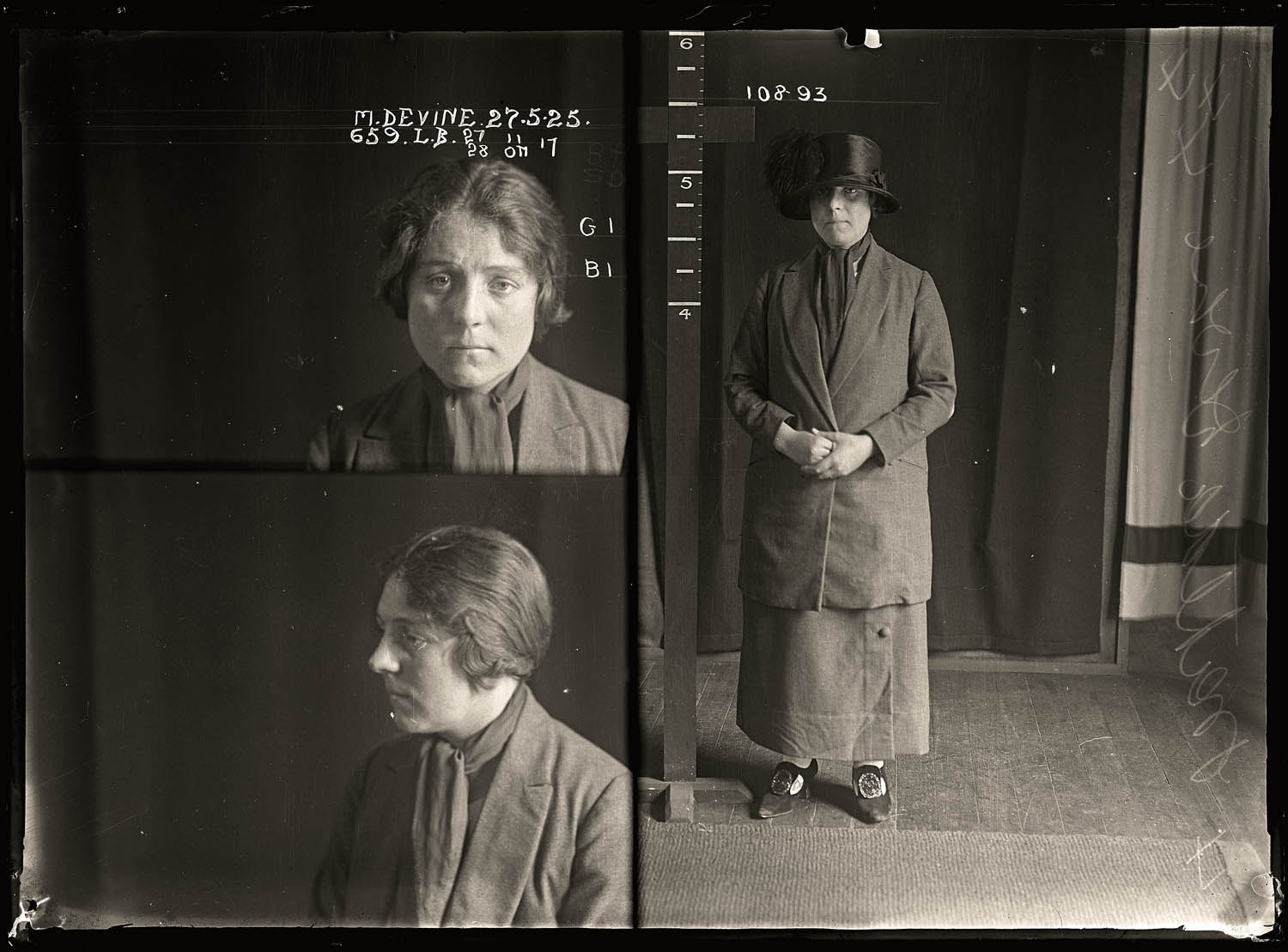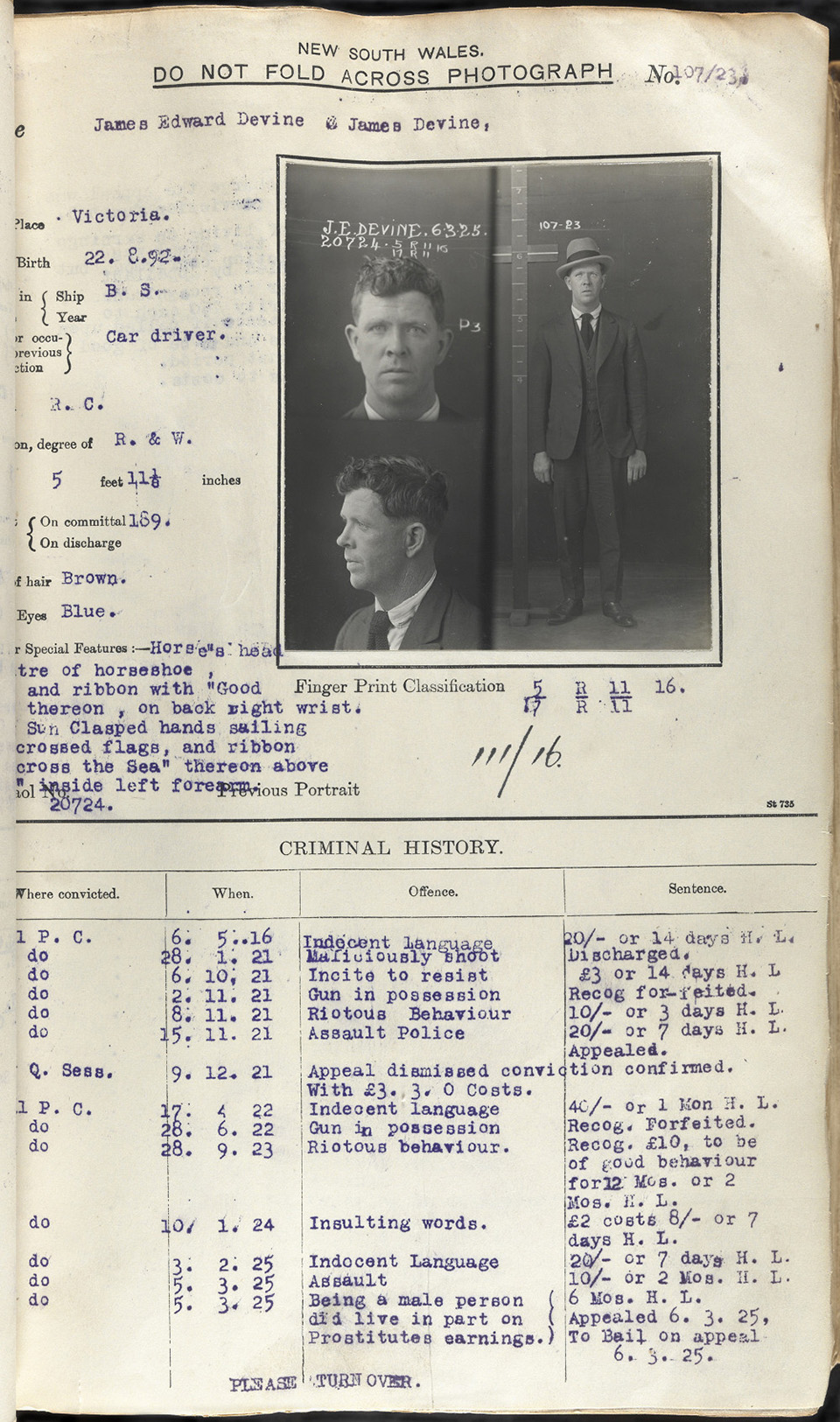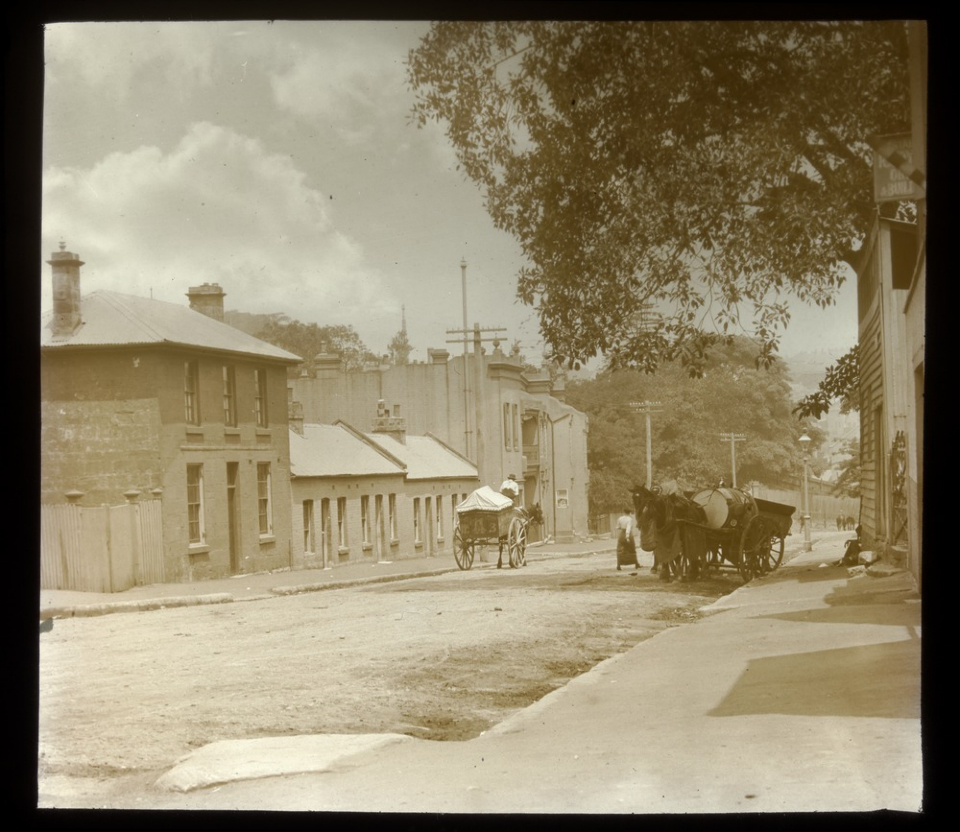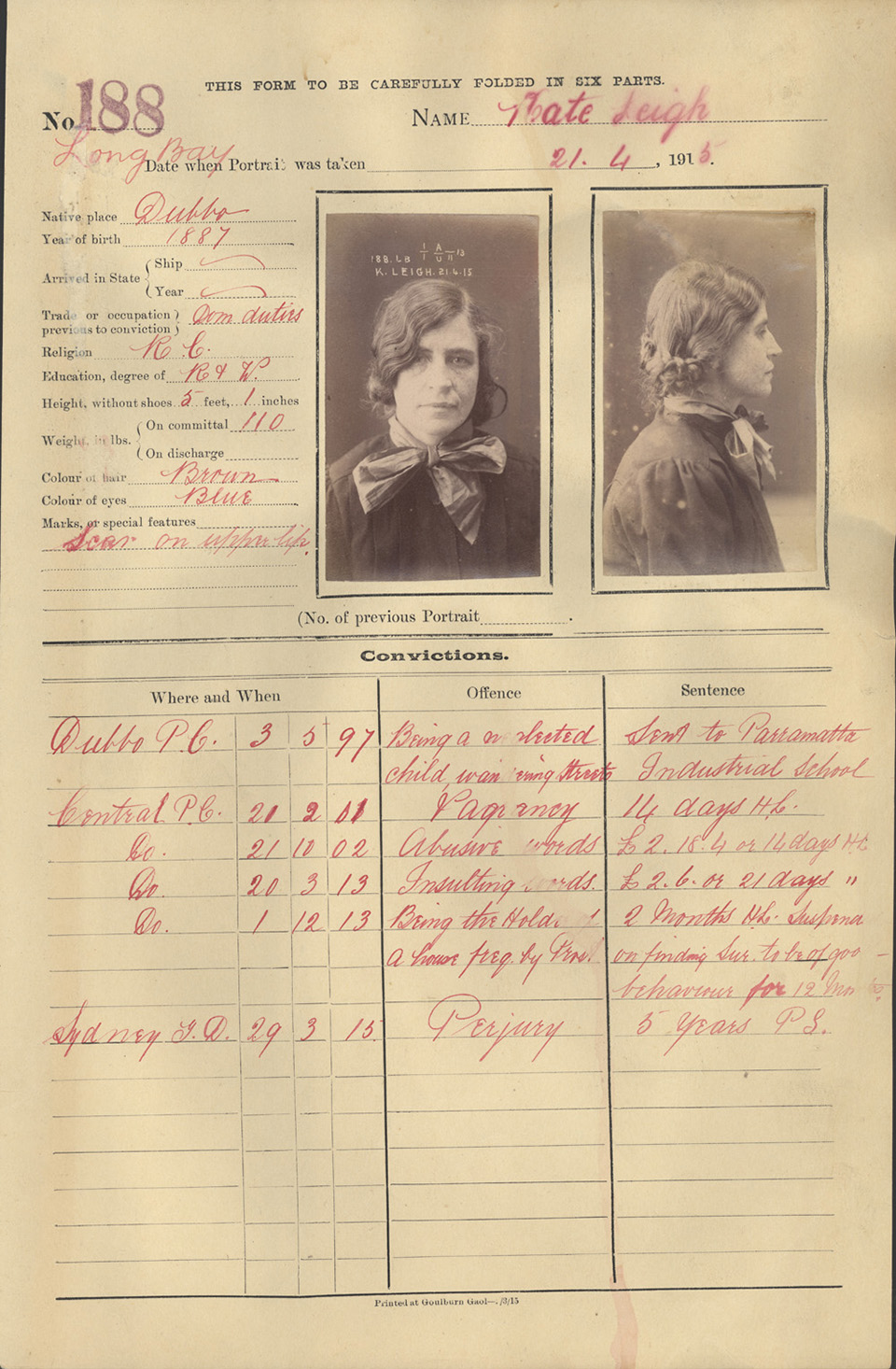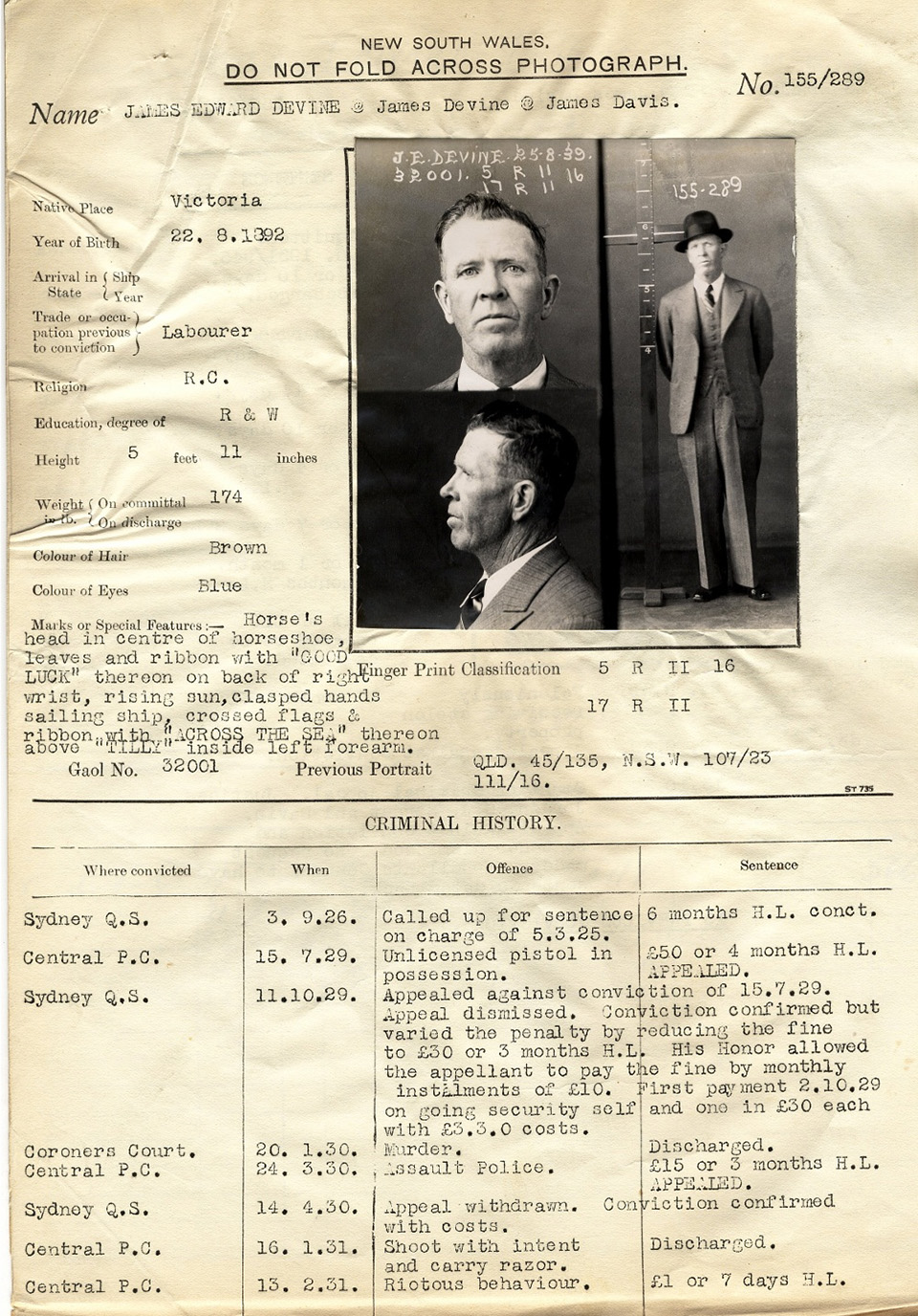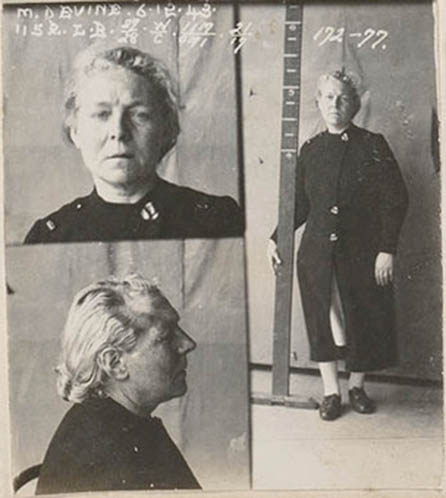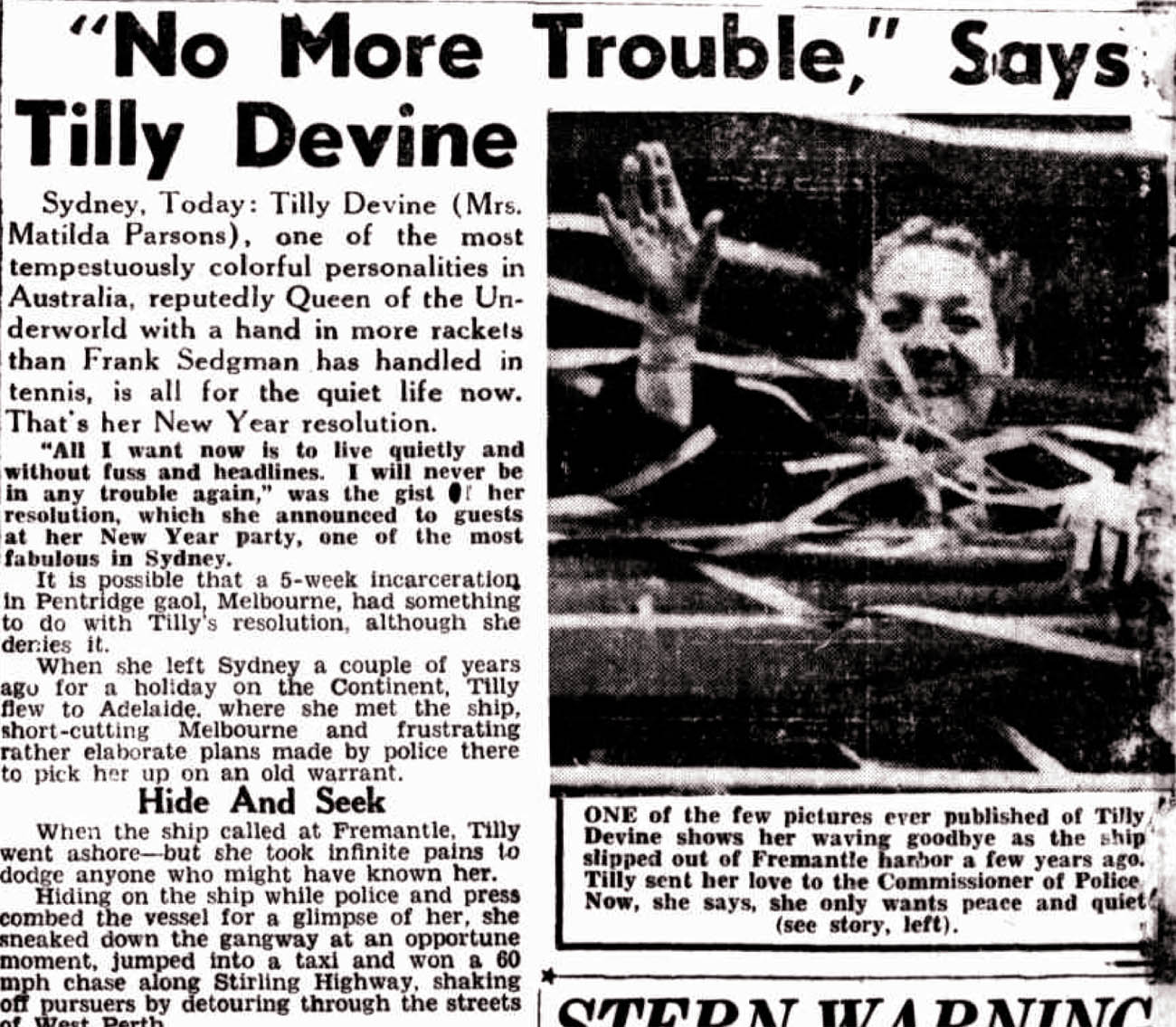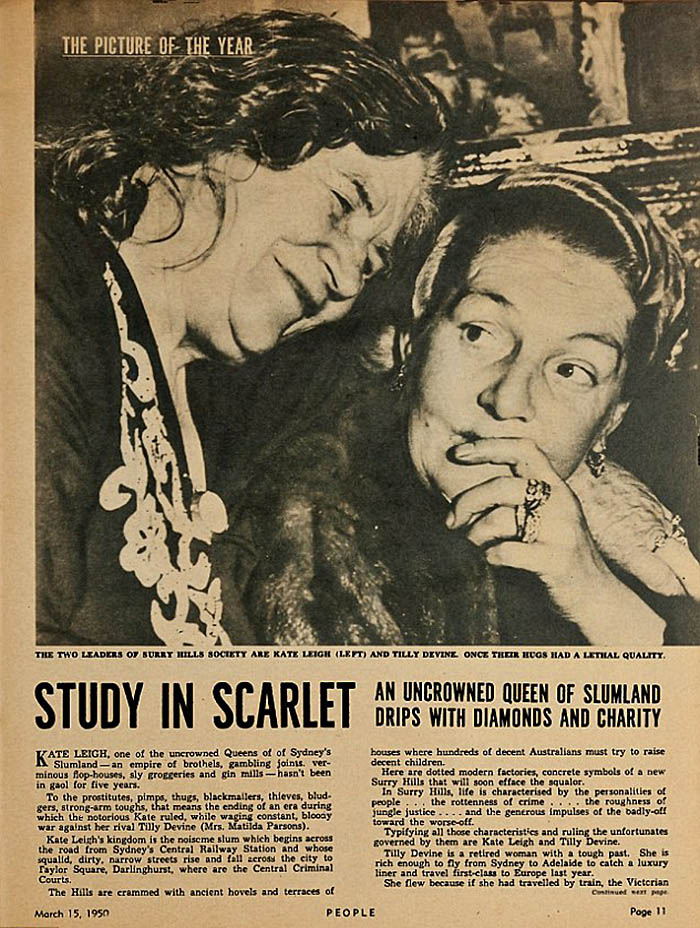The Dictionary of Sydney was archived in 2021.
Tilly Devine
Citation
Persistent URL for this entry
To cite this entry in text
To cite this entry in a Wikipedia footnote citation
To cite this entry as a Wikipedia External link
Matilda Mary (Tilly) Devine
[media]One of Sydney's most notorious women, Tilly Devine left the slums of London as a war bride bound for Sydney in 1920. Over the next four decades she became a wealthy madam and one of the city's most formidable underworld figures.
South London days
Tilly was born Matilda Mary Twiss on 8 September 1900 in Camberwell, South London. Camberwell was one of the worst slum areas in London, where lives were blighted by unimaginable poverty and violent crime. Tilly left school aged 12 and worked in one of the noxious trades factories that characterised the local area. Young, vivacious, pretty and streetwise, Tilly was determined to move out of poverty and became a streetwalker in the glamorous theatre area of the West End.
[media]In 1916 she met Australian James (Jim) Edward Joseph Devine, a sapper in the 4th Tunnelling Company of the Australian Imperial Force. They married on 12 August 1917 in the Church of the Sacred Heart of Jesus in Camberwell. Theirs was not a typical 'sweethearts in wartime' marriage but a relationship marked by physical and verbal violence, often exacerbated by excessive drinking. Yet Tilly's earnings as a prostitute were substantial and, with the protection of her husband, she continued to work the streets. In October 1918 she was arrested for soliciting on the Strand and was able to pay a hefty fine of 40 shillings rather than go to jail. [1]
The Devines in Paddington, Sydney
[media]Jim returned to Australia in 1919 and Tilly followed him on the 'war bride ship', the Waimana, which arrived in Sydney on 13 January 1920. Their young son, Frederick, remained in London with his grandparents. The Devines lived in a rented flat in Glenmore Road, Paddington, which was then a rundown slum area of overcrowded and badly constructed ramshackle dwellings. The inner eastern suburbs were also home to a notorious and violent underworld where crime, razor gangs, drug peddlers, sly grog sellers and brothels occupied a murky, seedy existence on the fringes of the city. This was the era of infamous Sydney criminal figures such as gangsters Guido Calletti, Frank Green, Phil 'the Jew' Jeffs and Norman Bruhn and prostitutes Nellie Cameron and Dulcie Markham. Tilly and Jim Devine fitted right in with this motley crew. [2]
Tilly resumed her old trade and with her good looks and wily ways she was able to charge the top price of ten shillings for her encounters. Jim acted as her pimp, protector, chauffeur and 'get away man.' Known locally as 'Big Jim', he also dealt illegal opium and cocaine. Between them they earned good money, yet it came with a hefty price.
Between 1921 and 1925 Tilly Devine was arrested on seventy-nine occasions for prostitution offences, often referred to in the criminal records as 'offensive behaviour' and 'indecent language'. She was also charged with fighting and consorting with known criminals. Usually she was fined or imprisoned for a few days. More sinister however was the charge of 'maliciously wounding' Sidney Cork, a confectioner living at 474 Bourke Street, with a razor blade in May 1925. His wound required 17 stitches and Tilly was sentenced to two years light labour in Long Bay Women's Prison. [3] The police report described Devine as 'a prostitute of the worst type and an associate of the worst types of prostitute, vagrants and criminals.' [4] However, inside Long Bay, she was known as 'Pretty Tilly.' [5]
Tilly the madam
Looks don't last and Tilly was determined to become a business woman. The New South Wales Police Offences (Amendment) Act of 1908 made it an offence for men to operate a brothel, act as a pimp, or profit from the earnings of prostitution. [6] The loophole was that this prohibition did not extend to women, and the ruthless and yet enterprising Tilly Devine jumped at the chance to become a madam. By the end of the 1920s Tilly had stopped prostituting herself and had become the owner of a string of brothels throughout the Surry Hills, Darlinghurst, Paddington and Woolloomooloo areas of the city. To guard her illegal empire she employed a large staff of standover men, bouncers and bodyguards to protect both her premises and the women working in them.
According to Larry Writer, Tilly's workers saw her as a 'benevolent despot'. [7] She demanded loyalty and honesty and rewarded those who worked hard and handed over their earnings. She provided food and lodgings, medical care and importantly, protection from violent or deviant customers. However, she was ruthless with those who hid their earnings and would sack them and often beat or maliciously wound them as a parting gift. In 1943 Tilly Devine was charged with maliciously wounding one of her prostitutes, Ellen Grimson, with a knife to the face. At the trial she claimed she had hit Grimson in self-defence with her diamond ringed fingers and that the wound had not been caused by a knife and was acquitted of the assault. [8]
Tilly Devine versus Kate Leigh
Tilly's bordellos, together with a thriving sideline of sly grog and drug peddling, earned her a substantial return and the Devines moved to a comfortable bungalow on the corner of Torrington and Malabar roads, in middle class Maroubra. Unfortunately for their respectable neighbours, the house would soon become a place of wild parties, violent arguments between Jim and Tilly, frequent police raids and fatal shootouts. Jim Devine shot his rival George 'Gunman' Gaffney here on 17 July 1929. [9] Before he died of his wounds, Gaffney refused to 'turn King's evidence' and say who had shot him. Big Jim was later found not guilty of murder on the grounds that he was defending himself, his wife and his home. [10]
George Gaffney [media]had been a leading figure in the underworld gang led by Tilly's great rival Kate Leigh, the queen of sly-grog in the Surry Hills area of Sydney, with her own flourishing business dealing in cocaine and stolen goods. For years the two women led two very dangerous and deadly gangs. On numerous occasions, they personally fought in the streets, whilst countless of their henchmen were slashed, stabbed and shot. In 1936, with the insistence of Police Commissioner William Mackay, they agreed to an uneasy truce. If the violence between them stopped, Tilly the Madam and Kate the sly-grogger would be permitted to continue their business activities with little interference from the police. It was a dubious, albeit sensible, compromise. [11]
The eventual cessation of gang warfare did not diminish Devine's notoriety. During the 1930s Tilly continued to make frequent appearances in court, usually for assault, indecent language and consorting offences. In court, her dress was always lavishly flamboyant with dripping diamonds, draped furs and dramatic hairdos while her demeanour was performative, modelled on the bawdy characters and music hall culture of London's working classes. These regular court appearances generated a strange mixture of voyeurism and amusement in Sydneysiders who watched from the often packed-out public gallery. [12]
[media]In January 1930 Tilly was charged with consorting, riotous behavior, and assaulting a police officer. Her defence lawyer promised the judge that Tilly would leave the country for two years, rather than be punished with yet another stretch in Long Bay. [13] She did indeed leave for London but was back in Sydney in less than a year. On her return, she had a blazing row with Jim Devine after she discovered he was having an affair. After shots were fired frightened neighbours called the police. Although Jim was charged with attempted murder, the case fell apart when Tilly refused to testify against him. [14]
World War II
[media]The Depression years hit Sydney hard and Tilly's businesses were not immune from its effects. However, with the arrival of thousands of American servicemen during World War II, Tilly's brothels boomed once again. The war also brought out her more benevolent side; she held respectable parties, the proceeds of which were given to Australian soldiers' families and she also gave generously to veteran's welfare associations and to children in hospital. [15]
In March 1943 Tilly filed for divorce from Jim Devine on the grounds of cruelty. She had put up with his infidelities, brutal violence and drunkenness for the past 27 years. [16] She quickly fell for Eric Parsons, a seaman and barman a few years younger than herself. However her own violent disposition erupted in February 1945; during a drunken argument Tilly shot Parsons and was arrested for attempted murder. [17] When the case went to court in March, Parsons refused to testify against her and the charge was dropped. [18] They married in May 1945 and their wedding party, which began on a Saturday night and continued well into the Sunday evening, culminated in a brawl and three arrests. [19] Despite this inauspicious start, their 12-year marriage seems to have been rather more successful than her first. Eric Parsons died from cancer in November 1958.
Return to London
[media]In 1948 Tilly sailed first class to England to visit her elderly father. She also returned to London with Eric to witness Queen Elizabeth's coronation in 1953. Her London escapades were elaborately noted in the gossip columns of both the British and Sydney newspapers, which feted her as being one of Sydney's wealthiest citizens. [20] This status however was soon to disappear.
In October 1955 the Australian Tax Department ordered Devine to pay $20,000 in unpaid income tax and fines. Despite her protests and appeals, she was forced to sell many of her properties off. By 1959, Tilly who had once been known as 'the Queen of the Night' with her extensive brothel empire had just one establishment left in Palmer Street. This closed in 1968, after being firebombed by new criminal entrepreneurs seeking to monopolise prostitution in East Sydney. In the same year the law that accidentally permitted women, but not men, to live off the earnings of prostitution, was amended. Times had changed, most of Tilly's razor-gang associates were dead and a new generation of rival gangs had risen. Tilly's long reign was over.
Death
[media]Once one of Sydney's most ruthless and wealthiest madams, Tilly Devine died in rather pathetic circumstances of poverty and pain. She had suffered from chronic bronchitis for twenty years before she succumbed to cancer in Concord Hospital on 24 November 1970. Kate Leigh received tributes but few Sydneysiders mourned the passing of Tilly Devine. Ron Saw's obituary in the Daily Telegraph was positively caustic:
A vicious, grasping, high-priestess of savagery, venery, obscenity and whoredom … She died friendless and alone, and for that she must be pitied. But if they hold a wake for her the sorrow will be slobber and crocodile tears. She was a wretched woman. [21]
There was no wake, and the Sydney Morning Herald obituary writer stated that, even at the Tradesmen's Arms in Palmer Street (the East Village Hotel), her favourite watering hole, 'nobody wanted to know' about her death. One old lady proposed a toast, 'but no-one bothered to drink.' [22]
Since her death, however, Tilly Devine has attained something of a legendary stature. Her life inspired Peter Kenna's play The Slaughter of St Teresa's Day and Larry Writer's successful book Razor; Tilly Devine, Kate Leigh and the Razor Gangs has been re-published many times since the first edition appeared in 2001. In 2009 a graphic exhibition at the Justice and Police Museum revealed the extent of her savage and merciless career.
The fascination for this notorious chapter of Sydney's history endures. The razor gang era features in the University of Sydney's history course Sin City: A History of Sydney. And her name, if perhaps not her legacy, is inscribed in the streetscape today with the popular and lively wine bar, Love, Tilly Devine in Crown Lane, Darlinghurst.
References
Judith Allen. Sex and Secrets: Crimes involving Australian Women since 1880. Melbourne: Oxford University Press, 1990.
Judith Allen and Baiba Irving. 'Devine, Matilda Mary (Tilly) (1900–1970)'. Australian Dictionary of Biography. 1981. http://adb.anu.edu.au/biography/devine-matilda-mary-tilly-5970/text10185, published first in hardcopy 1981.
Kay Saunders. Notorious Australian Women. Sydney: Harper Collins, 2011.
State Records NSW. Tilly Devine & the Razor Gang Wars, 1927-31. http://gallery.records.nsw.gov.au/index.php/galleries/people-of-interest/tilly-devine-the-razor-gang-wars-1927-31/.
Larry Writer. Razor: Tilly Devine, Kate Leigh and the razor gangs. South Melbourne: Pan Macmillan, 2009.
Notes
[1] Kay Saunders, Notorious Australian Women (Sydney: Harper Collins, 2011): 195
[2] Jim and Tilly earned formidable reputations; both could be foul-mouthed, vicious and ruthless with a weapon. By the end of the 1920s Darlinghurst was known as Razorhurst; razors became the weapon of choice for Sydney's criminals following the Pistol Licensing Act 1927 which threatened prison for anyone caught with an unregistered gun
[3] Brisbane Courier, Tuesday 24 March 1925: 15
[4] Police Report, 4 May 1925, in State Records NSW, 'Tilly Devine and the Razor Gang Wars', http://gallery.records.nsw.gov.au/index.php/galleries/people-of-interest/tilly-devine-the-razor-gang-wars-1927-31/, viewed 7 April 2016
[5] Larry Writer, Razor: Tilly Devine, Kate Leigh and the razor gangs (South Melbourne: Pan Macmillan, 2009): 29
[6] Kay Saunders, Notorious Australian Women (Sydney: Harper Collins, 2011): 196
[7] Larry Writer, Razor: Tilly Devine, Kate Leigh and the razor gangs (South Melbourne: Pan Macmillan, 2009): 31
[8] Sydney Morning Herald, Wednesday 13 October 1943: 10
[9] Sydney Morning Herald, 19 July 1929: 13
[10] Sydney Morning Herald, 14 September 1929: 14; Larry Writer Razor: Tilly Devine, Kate Leigh and the razor gangs (South Melbourne: Pan Macmillan, 2009): 109-12
[11] Larry Writer, Razor: Tilly Devine, Kate Leigh and the razor gangs (South Melbourne: Pan Macmillan, 2009): 205–07
[12] Sydney Morning Herald, 15 January 1932: 6; Sydney Morning Herald, 5 March 1932: 10; Advertiser, 9 February 1934: 12; Courier Mail, 7 June 1938: 5
[13] Sydney Morning Herald, 6 February 1930: 8
[14] Sydney Morning Herald, 17 January 1931: 10; Brisbane Courier, 10 January 1931: 22
[15] Larry Writer, Razor: Tilly Devine, Kate Leigh and the razor gangs (South Melbourne: Pan Macmillan, 2009): 256–57
[16] Jim later moved to Melbourne and died of pneumonia at Heidelberg on 18 August 1966
[17] Sydney Morning Herald, 21 February 1945: 5
[18] Sydney Morning Herald, 30 March 1945: 4
[19] Army News (Darwin), 23 May 1945: 2
[20] Courier-Mail (Brisbane) 7 February 1953: 4
[21] Daily Telegraph, 25 November, 1970: 6
[22] Sydney Morning Herald, 25 November 1970: 18
.



